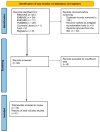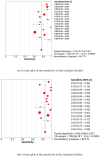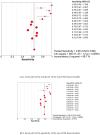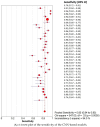Artificial Intelligence in Laryngeal Cancer Detection: A Systematic Review and Meta-Analysis
- PMID: 40558281
- PMCID: PMC12191837
- DOI: 10.3390/curroncol32060338
Artificial Intelligence in Laryngeal Cancer Detection: A Systematic Review and Meta-Analysis
Abstract
(1) Background: The early detection of laryngeal cancer is crucial for achieving superior patient outcomes and preserving laryngeal function. Artificial intelligence (AI) methodologies can expedite the triage of suspicious laryngeal lesions, thereby diminishing the critical timeframe required for clinical intervention. (2) Methods: We included all studies published up to February 2025. We conducted a systematic search across five major databases: MEDLINE, EMCARE, EMBASE, PubMed, and the Cochrane Library. We included 15 studies, with a total of 17,559 patients. A risk of bias assessment was performed using the QUADAS-2 tool. We conducted data synthesis using the Meta Disc 1.4 program. (3) Results: A meta-analysis revealed that AI demonstrated high sensitivity (78%) and specificity (86%), with a Pooled Diagnostic Odds Ratio of 53.77 (95% CI: 27.38 to 105.62) in detecting laryngeal cancer. The subset analysis revealed that CNN-based AI models are superior to non-CNN-based models in image analysis and lesion detection. (4) Conclusions: AI can be used in real-world settings due to its diagnostic accuracy, high sensitivity, and specificity.
Keywords: artificial intelligence (AI); laryngeal cancer; laryngoscopy; machine learning; otolaryngology.
Conflict of interest statement
The authors declare no conflicts of interest.
Figures











Similar articles
-
Artificial intelligence for detecting keratoconus.Cochrane Database Syst Rev. 2023 Nov 15;11(11):CD014911. doi: 10.1002/14651858.CD014911.pub2. Cochrane Database Syst Rev. 2023. PMID: 37965960 Free PMC article.
-
Signs and symptoms to determine if a patient presenting in primary care or hospital outpatient settings has COVID-19.Cochrane Database Syst Rev. 2022 May 20;5(5):CD013665. doi: 10.1002/14651858.CD013665.pub3. Cochrane Database Syst Rev. 2022. PMID: 35593186 Free PMC article.
-
Artificial intelligence for X-ray scaphoid fracture detection: a systematic review and diagnostic test accuracy meta-analysis.Eur Radiol. 2024 Jul;34(7):4341-4351. doi: 10.1007/s00330-023-10473-x. Epub 2023 Dec 15. Eur Radiol. 2024. PMID: 38097728 Free PMC article.
-
Performance of artificial intelligence on cervical vertebral maturation assessment: a systematic review and meta-analysis.BMC Oral Health. 2025 Feb 5;25(1):187. doi: 10.1186/s12903-025-05482-9. BMC Oral Health. 2025. PMID: 39910512 Free PMC article.
-
Triage tools for detecting cervical spine injury in pediatric trauma patients.Cochrane Database Syst Rev. 2017 Dec 7;12(12):CD011686. doi: 10.1002/14651858.CD011686.pub2. Cochrane Database Syst Rev. 2017. Update in: Cochrane Database Syst Rev. 2024 Mar 22;3:CD011686. doi: 10.1002/14651858.CD011686.pub3. PMID: 29215711 Free PMC article. Updated.
References
Publication types
MeSH terms
LinkOut - more resources
Full Text Sources

